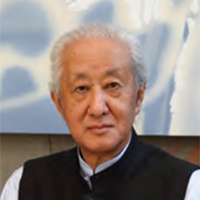The skyscraper has been designed by architects Arata Isozaki and Andrea Maffei. Standing at a total height of 242 meters, the Allianz tower is now the tallest building in Italy, if you don't have in consideration the spire of Cesar Pelli’s Unicredit Complex, also in Milan. The floor plan, measuring a total of 21×58 meters, have a narrow footprint that accentuates the building’s verticality, with a slender shape extending above Milan’s existing urban fabric.
Description of the project by Arata Isozaki + Andrea Maffe
Milan is the city that best represents the international face of Italy, comparable to London, Frankfurt, Paris. Unlike many historical Italian cities, Milan is more related to its development in the nineteenth and twentieth century, to be more precise after the industrial revolution.
In this sense, design in Milan is compared with the more contemporary face of Italy, made up of factories, subways, concrete and steel and not so much of particular historical presences. Witness is the fact that the Futurist movement has developed mainly in Milan, a movement created to respond to the issues of the contemporary city. It was not a particularly important relationship with the large existing masterpieces, but rather a reflection on the themes of the contemporary city.
To develop the project, we immediately thought it was not interesting to rely on a single architect for the design of the whole complex, but to start a dialogue. Due to the size of the area we decided to aspire to re-interpret the complexity of the city through many architects who brought the idea of buildings with different shapes and materials.
In any street in Milan there are buildings from different periods and with different architectural features. From this belongs the life of a city, in the dynamic tension between the works of later periods in an archipelago of images and colors. This was our ambition, choosing to work in a group.
In our archipelago forms, we found interesting to develop the idea of a skyscraper without a limit, a kind of endless tower. Now we find skyscrapers of any shape and decoration in all parts of the world. Starting from this study, we looked to a fascinating concept to be applied to high-rise buildings, instead of studying only a shape of an aesthetic beauty.
In the aspiration of maximum verticality and tension towards the sky, it was a limit to choose a complete shape and concluded at a certain height and we preferred to apply the concept of a modular system that can be repeated in an infinite way with any limit.
The module we decided is composed by 6 office floors with a long thin plan of 24x61.5m. The choice of these proportions is finalised to make the whole volume thinner to emphasize the verticality and makes it structurally provocative, due to the slender shape so high.
The facade of the module is composed by a triple glass unit slightly curved to outside. The vertical succession of rounded forms create a feeling of slight vibration of the volume of the building as it rises upward. Elevations of the short sides are fully glazed and show the mechanical series of panoramic lifts going up and down to the various floors of the building.
The idea of endless tower can be compared to previous ambitions of other artists as Constantin Brancusi, for example, who in 1937-38 installed one of his endless column of Targu-Jiu in the park to create repeatable systems indefinitely. When asked about the reasons for this idea, Brancusi replied: "We need to support the vault of heaven."
CREDITS. DATA SHEET.-
Architects.- Arata Isozaki , Andrea Maffei.
Design Team.- Pietro Bertozzi, Takeshi Miura, Alessandra De Stefani, Chiara Zandri, Vincenzo Carapellese, Roberto Balduzzi, Francesca Chezzi, Takatoshi Oki, Stefano Bergagna, Paolo Evolvi, Elisabetta Borgiotti, Davide Cazzaniga, Adolfo Berardozzi, Hidenari Arai, Higaki Seisuke, Taro Hayashi, Takuichiro Yamamoto, Giuliano Godoli, Giorgio Ramponi, Carlotta Maranesi, Atsuko Suzuki, Sofia Bedynski, Antonietta Bavaro, Mauro Mazzali, Sofia Cattinari, Haruna Watanabe, Madoka Tomita, Ayako Fujisawa.
Structure.- Competition.- Mutsuro Sasaki, Hiroki Kume, Takeshi Suzuki / Sasaki and Partners, Tokyo. Project.- Maurizio Teora, Luca Buzzoni, David Scott, Matteo Baffetti, Valeria Migliori, Francesco Petrella, Angelo Mussi / Arup, Milano and New York, basement structures: Holzner Bertagnolli, Cap Engineering.
Façades.- Mikkel Kragh, Mauricio Cardenas, Matteo Orlandi, Maria Meizoso, Carlos Prada / Arup Milano and Madrid.
Plants.- Competition.- P.T. Morimura, Tokyo. Project.- Gianfranco Ariatta, Roberto Menghini, Riccardo Lucchese, Sylvia Zoppo Vigna, Andrea Ambrosi / Ariatta Ingegneria dei sistemi, Milano.
Fire Project.- Ing. Salvatore Mistretta, Milano.
Vertical Transportation.- Hans Jappsen / Jappsen Ingenieure, Frankfurt.
Lighting Design.- LPA – Light Planners Associates, Tokyo.
LEED certification.- Fabio Viero, Gioargio Butturini / Manens-Tifs s.p.a.
Project Management.- Giorgio Montagna, Valentina Guagenti, Francesca Milani, Valentina Grassi / J&A, Milano, Alberto Ferrari, Pietro Baccarelli / Ramboll, London.
General Contractors.- Colombo Costruzioni S.p.A. , Focchi S.p.A.
Construction Manager.- Claudio Guido / In.Pro s.r.l.
Construction Documents.- Andrea Matricardi / Mpartner, Franco Mola / ECDS, Francesco Iorio / Studio Iorio, Michele Capè / Studio Capè, Ariatta Ingegneria dei Sistemi.
Construction Security.- Donato Bertoncelli / Gestione Progetti.
Cost Control.- Aldo Bottini, Stefano Rocca / BMS Progetti.
Client.- Citylife S.p.A. / Armando Borghi, Marco Beccati - project director, Roberta Pasinetti - technical director, Roberto Russo, Andrea Zerbini, Gianni Armas, Martino Negri.
Area.- 81615.0 sqm.
Project Year.- Competition.- 2004. Design.- 2005-2011. Construction.- 2012 – 2015.
Gross floor area above ground.- 81.615 sqm.
Gross floor area below ground.- 44.485 sqm.
Height.- 242 m.
















































